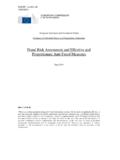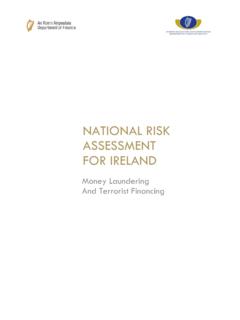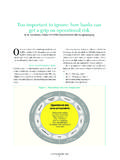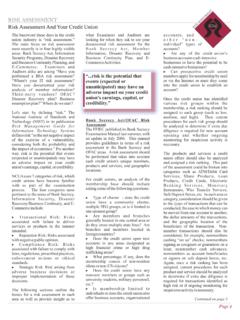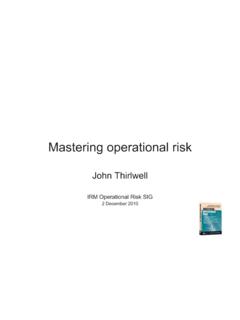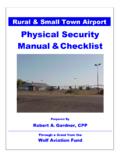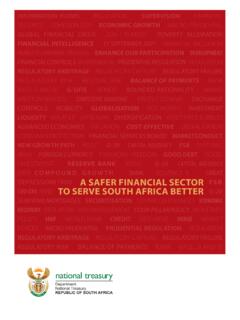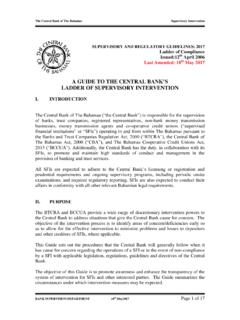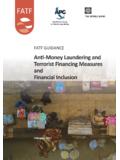Transcription of Executive Summary EXECUTIVE SUMMARY - FATF …
1 Preface EXECUTIVE SUMMARY EXECUTIVE SUMMARY . 1. This report provides a SUMMARY of the anti-money laundering and combating the financing of terrorism (AML/CFT) measures in place in Singapore as at the date of the on-site visit (17 November 2015 to 3 December 2015). It analyses the level of compliance with the FATF. 40 Recommendations and the level of effectiveness of Singapore's AML/CFT system, and provides recommendations on how the system could be strengthened. Key Findings Singapore's AML/CFT coordination is highly sophisticated and inclusive of all relevant competent authorities. Driven by the AML/CFT Steering Committee and the Inter-Agency Committee, the coordination mechanism in Singapore is a very valuable tool in AML/CFT policy development. This proved to be true in the development of the National Risk Assessment (NRA). and the cooperation and organisation associated with this mutual evaluation exercise. Singapore has a strong focus on law and order and enforcement, which often result in dissuasive penalties.
2 Singapore has a reasonable understanding of its ML risks and has taken steps to mitigate them. Nevertheless, moderate gaps remain. In particular the nexus between transnational threats, the inherent risks faced by Singapore as one of the world's largest financial centres, and vulnerabilities within the system is not sufficiently reflected in Singapore's NRA. Singapore's ability to proactively identify and address serious foreign predicate ML, and transnational ML networks will be strengthened with moderate improvements in Singapore's understanding of its foreign predicate ML risks. Singapore provided information that it was pursuing some complex cases involving transnational fraud and corruption. However, Singapore has prosecuted few foreign predicate ML cases outside of wire transfer frauds involving money mules/shell companies, and has confiscated low amounts of proceeds of crime. Singapore has demonstrated that it has a general understanding of its TF risks. But the weighting placed in the risk methodology on indicators derived from reported incidences in Singapore has somewhat hindered Singapore's ability to appreciate the inherent TF risks associated to its geographical location and its status as a global financial centre.
3 Anti-money laundering and counter-terrorist financing measures in Singapore 2016 @ FATF and APG 2016. 3. EXECUTIVE SUMMARY . Singapore's FIU, the Suspicious Transactions Reporting Office (STRO), uses well-functioning systems and coordination mechanisms to integrate FIU information into LEA processes. Singapore's primary investigative agencies routinely make significant use of STRs at early stages of ML and predicate investigations. While financial intelligence information is provided to other agencies, they are yet to make significant use of such information to support investigation. STRs relating to TF, while routinely disclosed to the Internal Security Department (ISD), have not resulted in any criminal investigations. Singapore's FIs generally demonstrated a reasonably good understanding of ML risks impacting Singapore domestic clients, but a less developed understanding of the risk of illicit flows into and out of Singapore. FIs and especially DNFBPs had a less mature understanding of TF risks, and often failed to distinguish between terrorism and TF risks.
4 Overall, there is a significant difference in the level of understanding of the ML/TF risks between the financial sector and DNFBP sector, therefore limiting DNFBPs' ability to develop a comprehensive risk understanding. For most FIs, AML/CFT supervision appears robust, with a variety of off-site factors examined and comprehensive on-site examinations/follow-up being conducted. Singapore has recently extended AML/CFT supervision to most types of DNFBPs, but there are significant differences in effective supervision of AML/CFT requirements between relevant supervisory bodies. While Singapore has a range of remedial measures that it can impose on FIs, the financial penalty structure across the DNFBP sector is quite diverse and concerns exist about the differences in approach in terms of dissuasiveness and proportionality. Apart from the casino and TSP sectors, sanctions for non-compliance by DNFBPs have not been tested. Singapore has not undertaken an adequate ML/TF risk assessment of all forms of legal persons and legal arrangements.
5 Authorities however acknowledge that legal persons and arrangements created in Singapore, and those registered or operating in Singapore from foreign jurisdictions, can be used to facilitate predicate crimes and ML/TF offences. Singapore has implemented some preventive measures designed to prevent the misuse of legal persons and arrangements for ML. and TF, including the collection of beneficial ownership information by FIs and DNFBPs. However, in practice, some DNFPBs do face challenges in obtaining beneficial ownership information. On international cooperation, Singapore provides constructive and high quality information and assistance when requested, but faced occasional challenges executing some MLA requests in a timely manner. Although few outgoing MLA requests were made prior to 2015, Singapore has taken steps to increase outgoing MLA requests in 2015, more than doubling the entire number of MLA requests in the previous 3 years. Singapore also uses informal channels and the LEAs, FIU.
6 And financial supervisors are generally well engaged in making and receiving requests where permitted. Singapore shares domestically available beneficial ownership information for legal persons and legal arrangements, however there is limited information available under the domestic framework. 4 Anti-money laundering and counter-terrorist financing measures in Singapore 2016 @ FATF and APG 2016. EXECUTIVE SUMMARY . Risks and General Situation 2. Singapore maintains one of the lowest domestic crime rates in the world,1 and therefore, the bulk of Singapore's exposure to ML risks arises from offences committed overseas. In particular, Singapore's status as both a major global financial centre and an international trade/transportation hub makes it vulnerable to becoming a transit point for illicit funds from abroad. According to Singaporean authorities, foreign predicate offences constituted 66% of all ML investigations and 27% of all ML convictions in Singapore between 2008 and 2014.
7 Singapore's NRA published in January 2014 identifies common predicate offences committed in Singapore ( cheating (the term which Singapore uses for fraud), unlicensed money lending (UML) and criminal breach of trust (CBT), as well as foreign predicate cheating offences and proceeds of overseas corruption as posing relatively higher ML threats to Singapore. 3. The main conduits of ML identified in the NRA are banks, remittance agents, shell companies and individual money mules. Around 77% of the funds managed in Singapore are foreign sourced, with the majority of assets under management coming from the Asia-Pacific region. The size and foreign exposure of Singapore's private banking and asset management industry increases Singapore's ML/TF vulnerabilities. In addition, Singapore's position as an international trade/transportation hub also increases its ML/TF vulnerabilities. Given the complexity and large volume of trade financing services offered in Singapore, this banking sub-sector is also exposed to a higher level of ML/TF risk.)
8 Moreover, legal persons and arrangements also remain vulnerable to misuse given the broad range of financial services available. 4. Singapore is situated in a region where several terrorist groups operate actively and have carried out attacks in the last 10 years. Singapore's NRA report highlights that there has been no evidence of TF being committed in Singapore or terrorist funds flowing into or through Singapore.. An assessment of the TF threat posed by ISIL was subsequently conducted, and the findings were communicated to all FI, DNFBP and NPO supervisors. Overall Level of Effectiveness and Technical Compliance 5. Singapore's AML/CFT regime has undergone significant reform since the last assessment in 2008. Singapore has a strong legal and institutional framework for combating ML, TF, and PF. Technical deficiencies identified in Singapore's ML offence were addressed in 2010, and more recently the crime of ML was extended to cover more predicate offences, such as serious tax offences.
9 The technical compliance framework is particularly strong regarding law enforcement, confiscation, targeted financial sanctions, preventive measures for and the supervision of FIs, and international cooperation but less so regarding transparency of legal persons and arrangements, and preventive measures and sanctions for non-compliance for DNFBPs. 6. In terms of effectiveness, Singapore achieves substantial results in risk understanding and mitigation, international cooperation, collection and use of financial intelligence, and proliferation financing, and only moderate improvements are needed in these areas. More significant improvements are needed in other areas as indicated below. 1 According to data presented in the United Nations Office on Drugs and Crime (UNODC)'s report on International Statistics on Crime and Justice. See also: Anti-money laundering and counter-terrorist financing measures in Singapore 2016 @ FATF and APG 2016. 5. EXECUTIVE SUMMARY . Assessment of Risks, coordination and policy setting (Chapter 2 - ; , , ).
10 7. Singapore's AML/CFT coordination at the operational level is highly effective and inclusive of all relevant competent authorities. The Inter-Agency Committee coordinated the development of the National Risk Assessment (NRA) and the cooperation and organisation associated with the mutual evaluation. Singapore authorities consult across the private sector in AML/CFT policy development including the development of the NRA. Operational activities of authorities are targeted towards identified risk and resources are allocated accordingly both in terms of quantity and quality. 8. The NRA process has established a basis for the private sector and government agencies to understand Singapore's ML/TF risks. However, there remain moderate gaps in Singapore's overall understanding of risk. While Singapore has taken mitigation efforts to address the transnational risks that it has identified (such as from shell companies, trade based money laundering, as well as laundering of proceeds of corruption and tax evasion), some other forms of ML and TF relevant to Singapore's context should have been given greater attention.










